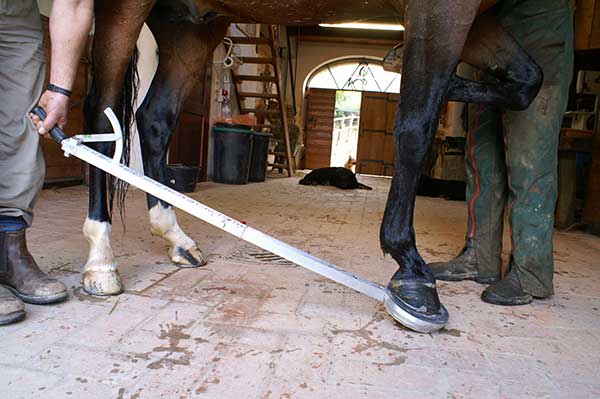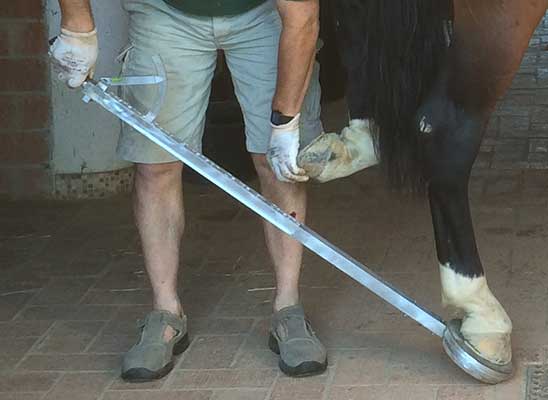 |
The use of the Digital Extension device in hind limbs |
||||||||||||||||||||
Introduction: |
||||||||||||||||||||
 |
||||||||||||||||||||
A reminder. The Digital extension Device (DED) was used about 15 years ago to measure 250 sound horse’s front limbs thereby establishing the normal range of tolerance of the front feet of sound horses to dorsal extension and medial and lateral elevation.[1] |
||||||||||||||||||||
|
||||||||||||||||||||
 |
||||||||||||||||||||
|
||||||||||||||||||||
In the original study the tollerance to palmar elevation and the tollerances of the hind limb were not measured. Now , many years of clinical practice later, these other measurements give us some tantalizing clues on the normal phisiology of the horse, bearing in mind that these results do not have the same statistical values behind them as the above mentioned dorsal, lateral and medial measurements of the front limbs. The following will discuss these results, with theauthor’s speculations in italics. Palmar elevation: |
||||||||||||||||||||
 |
||||||||||||||||||||
Lifting the heels of the front foot with the opposite limb held of the ground can usually be done with the same device as for the other tests. As there is no statistical study on tolerance to palmar elevation but just an accumulation of clinical experience, the author pre-sets the angle measurer at 25° and sees if the horse tolerates heel lift up to this point. From experience the author considers anything below 25° tolerance suspect; in other words if the limb does not tolerate a 25° heel lift there might be a problem, such as suspensory ligament desmitis, superficial flexor tendonitis, ring bone (enthesophyte formation at the sites of the distal extensor tendon insertions). The DED does not give a diagnosis, but it is useful in giving shoeing tips; if the horse tolerates less than 25° heel lift on a front foot, raised heel shoeing, egg bar and reverse shoes must be avoided and/or the heels might need more trimming. |
||||||||||||||||||||
Hind limbs, lateromedial elevation measurements: |
||||||||||||||||||||
It is virtually impossible to do good lateral or medial elevation measurements of the hind limbs, at least with the DED as it is constructed now; the hind limb just seems to swivel the toe of the foot towards the direction of elevation, negating a 90° angle between the hoof’s length axis and the DED handle. This in itself is fascinating as it completely at odds with the functioning of the front limbs. The author suspects that this effect is due to the hip joint with its ball in socket construct. It allows for interesting speculation, for example it could explain the much higher clinical tolerance of horses affected with PIP arthrosis in the hind limb(s) than in the front limb(s). In this light it is interesting to note that hind feet tolerate (and even require in some cases) lateral extensions, whereas the front feet usually will not tolerate this. The author finds the use of asymmetrical shoes in the hind feet much more successful than in the front feet. Hind limbs plantar and dorsal elevation: |
||||||||||||||||||||
|
||||||||||||||||||||
The tolerance to plantar elevation in the hind limbs is much higher than in front limbs, the author pre-sets the angle on the goniometer at 35° and tests if the horse tolerates this. Any tolerance below this degree is suspect. Horses with “high” suspensory problems in the hind limbs consistently show much lower degrees of tolerance to plantar elevation, horses with bone spavin are not affected in this test. The dorsal extension (elevation) on hind limbs can usually be done with the same device, unless the horse is very small. The results are totally different from the front feet in sound horses; the heels of the hind feetlift of anywhere between 16° and 22°, while it is rare for the front feet’s heels to lift of the DED plate during this test and the tolerated degree in sound horses on the fronts is in the range of the high thirties or low forties. This could explain several issues: the usually stronger wear of hind shoes at the toe, or the low clinical incidence of navicular type syndrome in the hind limbs, or again the seriousness of suspensory ligament desmitis in the hind limb. On the other hand, the hind limbs are the driving force in propulsion, which conceivably would be less effective if their dorsal extension would be as high as in the fronts. |
||||||||||||||||||||
Conclusions: |
||||||||||||||||||||
The normal function (physiology) of the hind limb is quite different from the front limb and it would be useful to have more science-based data on its ranges of tolerated motion. For this, a new study on a statistically significant number of sound horses, similar to the original study on the front feet with the help of the DED would be useful. In addition, there is a need to establish statistically sound data on the tolerance to palmar elevation, which was lacking on the front feet’s original study. It is the author’s hope that some younger researcher will be willing to take up the flame. [1] Castelijns H.H.,” How to use a Digital Extension Device in lameness Examinations”, AAEP Proceedings, vol.54, 2008, pp 228-231. The author has no commercial interests to declare. |
||||||||||||||||||||
Hans Castelijns
D.V.M - Certified Farrier



